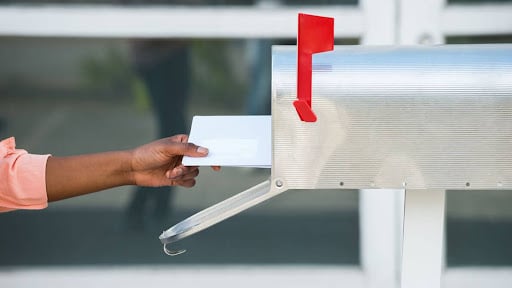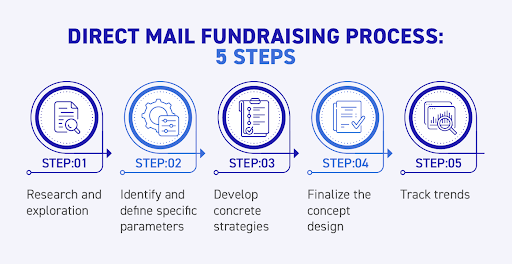

Direct mail fundraising should be an integral part of your nonprofit’s direct response strategy. When leveraged with other communication channels, direct mail can generate significant engagement and gift-giving from donors. Direct mail fundraising can also feel more personal for donors, especially when your messaging aligns with their preferences.
This guide walks through the basics of direct mail fundraising for nonprofits and how to launch a direct mail campaign:
Putting together an effective direct mail fundraising campaign requires a significant amount of time and effort, from researching your nonprofit’s current marketing position to developing creative concepts. Because this process can be so extensive, it’s best to partner with a team of experienced marketing experts when launching a new direct mail program.
Let’s get started!

Direct mail fundraising, sometimes called direct mail solicitation or direct marketing, is the process of mailing requests for support to existing and prospective donors.
Direct mail gives your supporters a physical object to connect them to your organization, making it a highly personal way to reach out. Additionally, holding onto physical mail may remind them to make another gift in the future.
Yes, direct mail fundraising does work. While it’s commonly believed that direct mail is ineffective or even “dead,” this is far from the truth. Studies show that 63% of Gen Z consumers were more excited about direct mail in 2022 than they had been in previous years. This shows that appreciation for this communication channel is growing among younger generations.
Additionally, audiences are likely to open and engage with direct mail. On average, direct mail has an open rate of 57.5% to 85%. This channel also tends to see positive returns—for every $1.27 spent on direct mail, companies earn an average return of $4.09.
Direct mail can benefit your nonprofit in many ways, from connecting with donors in a personal way and yielding a high ROI. Some of the other reasons to use direct mail fundraising include:
Direct mail fundraising can be a valuable part of your organization’s fundraising and marketing strategy, particularly when integrated with other channels. Link direct mail to other channels using scannable QR codes that lead to landing pages, donation forms, or social media posts. Consider pairing each direct mail campaign with email follow-ups that reinforce the key message and encourage supporters to donate online.
Designing a direct mail fundraising campaign involves many moving parts, from conducting intensive donor research to enlisting marketing strategists who will develop messaging frameworks and concepts. Partnering with a qualified agency with years of experience can help you manage these various parts and form a cohesive, high-quality final product.
Let’s take a closer look at each stage of designing a direct mail campaign.

The first step in creating any marketing campaign is to conduct preliminary research that investigates and explores data about your organization’s current audience and past campaigns.
Analyzing your nonprofit’s data and industry trends can uncover insights about:
This initial phase of research can give you and your direct mail fundraising partners a better idea of what your organization is working with, what the broader market of supporters value, and how you can stand out against peer organizations. Once you have a deep understanding of your position in the market, you can begin outlining specific focus areas that will shape your direct mail campaign’s message.
After completing the research phase, you’ll work with your partner agency to identify clear key audiences, define the campaign’s goals, and build frameworks for tracking its performance.
To identify a target audience for your campaign, you’ll need to dig deeper with your research. Take a closer look at both your existing supporters as well as how the general population interacts with similar organizations to identify their motivations for giving. Then, pair those motivations with demographic descriptors to paint a more detailed picture of the audience your direct mail fundraising efforts will target.
Here are a few activities to consider completing during this step:
When your nonprofit has a deep understanding of its donors’ affinity for your cause, it can create messages that pinpoint the specific reasons they support your cause.
Once you’ve gathered and interpreted these data points, use the audience profiles and market opportunities to structure early concepts for your direct mail campaign. Continue to use this data to justify the decisions you make for the campaign.
After performing extensive research and organizing your findings, you and your direct mail agency can begin brainstorming potential concepts for the campaign. Start by mapping the journey your supporters follow when engaging with your organization. Map their first touchpoint or exposure to your nonprofit (which is often a visit to your website) all the way to the step when they make a donation. Within those steps, look for gaps in the journey where potential supporters might abandon the process before they give.
These gaps can help you spot opportunities to leverage the power of direct mail fundraising to recapture prospective and current donors who may have strayed from your nonprofit. A personalized, engaging campaign can also deepen relationships with supporters who are already passionate about your cause. Intertwining what you know about your audience and their giving journey with strategy and creative executions can create an impactful and effective campaign.
Consider incorporating these strategies into your preliminary concepts for the campaign:
As you begin transforming small, abstract ideas into concrete first drafts, continuously check in with your audience research. Identify any major changes that come up if they have the potential to impact the campaign’s success. To confirm that your strategies are effective and align with your audience’s preferences, conduct tests with members of your target audience, measuring brand awareness and likelihood to support your cause.
The next step in the planning process is to choose winning concepts and refine and finalize them. Data comes in handy again at this step. Use the data you’ve gathered along the way to narrow down your most effective concepts and messaging strategies.
Next, prioritize the best ways to implement the overarching concept or message in your direct mail campaign. Use the past performance of similar concepts as a predictor of your new strategies’ success. Ask yourself and your team questions like:
Asking these questions ensures that you choose a concept that works for both your audience and your organization.
As you finalize your concepts and refine creative executions, begin drafting a specific timeline and implementation plan for the campaign. This plan is where your research, goals, task assignments, and resource allocation guidelines will live. Use this plan to guide the entire campaign, helping keep everyone on the same page and making the campaign run smoothly.
Keep your finger on the pulse of direct mail trends and audience preferences. These trends reveal what your peers are doing and what strategies resonate most with audiences. Study these patterns, compare them against your audience’s preferences, and adjust your strategy accordingly.
Some of the top trends in direct mail include:
Remember that overall, it’s more important to align with what your supporters want rather than blindly following trends. Refer to your data to make inferences about what would motivate your audience to engage. An experienced marketing agency can also provide guidance about which tactics and strategies to use.